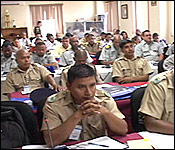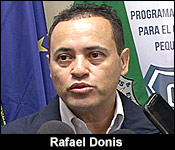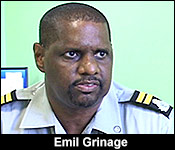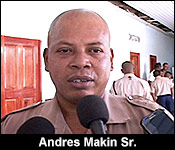
 Where do all the guns come from? IT's a question that has no easy answers - if it has any at all. But, for sure, many of them do come in through regulated border crossings and ports of entry - passing right beneath the noses of customs examiners. It's a problem throughout Central America, which - between Honduras, Salvador, Guatemala and Belize is the deadliest area on earth.
Where do all the guns come from? IT's a question that has no easy answers - if it has any at all. But, for sure, many of them do come in through regulated border crossings and ports of entry - passing right beneath the noses of customs examiners. It's a problem throughout Central America, which - between Honduras, Salvador, Guatemala and Belize is the deadliest area on earth.
That's what the Central American Program on Small Arms and Light Weapons Control, CASAC wants to combat. This morning they pulled together 39 police and customs officers at the Customs Department Office in Port Loyola, Belize City, for the first of a 3 day training on how to stop weapons from coming into the country. CASAC has brought in experts on how to detect and interdict weapons smuggling. We spoke with the facilitators:
 Rafael Donis - Firearms Expert, CASAC
Rafael Donis - Firearms Expert, CASAC
"It's a training program based on firearms controls and it also deals with the logistical details guarding, protecting the borders, the entry points and they will also be covering details on how different criminal elements try to hide the firearms in smaller pieces and disguise them in other forms and then bring them through water, land and through air."
Emil Grinage - Acting Comptroller of Customs
 "As you saw, it has to do with training of customs officers and the police department in how to handle the trafficking the firearm, especially small firearms. You know the death rate in Belize is high, most contributed to firearms and we being the frontline people will be able to try and intercept as best and possible in working together to try and intercept these arms and see if we could contribute to the best part of Belize, the national security of Belize."
"As you saw, it has to do with training of customs officers and the police department in how to handle the trafficking the firearm, especially small firearms. You know the death rate in Belize is high, most contributed to firearms and we being the frontline people will be able to try and intercept as best and possible in working together to try and intercept these arms and see if we could contribute to the best part of Belize, the national security of Belize."
Andres Makin Sr. - OC, Dangerous Goods Desk, Police
"It's a regional initiative that is given to Central American countries and knowing the situation with firearms in our country, we were ask to be participants of this training and which I believe will be fruitful for us in the near future when it comes to dealing with firearms and firearms smuggling."
Daniel Ortiz
"Let's say for example. I am a firearms smuggles, I'm trying to get arms into a country. How does an officer try to stop me?"
Rafael Donis - Firearms Expert, CASAC
"The public officers who are here are stationed in different border points/entry points and each of them will become specialized in detecting these weapons who are being brought by pieces, smaller pieces come in different containers, and so they would be able to develop the capacity to detect whether they are in charge of a maritime post, an airline, an entry point. In addition to learning how to detect different forms and modes of illicit transportation of these firearms or their parts/components, these public officers will be specialize in profiling the potential trafficker in firearms and they will be able to detect the kind of like the modus operandi, the different agencies that they attempt to corrupt."
 Andres Makin Sr.
Andres Makin Sr.
"It will have an impact. It will help in a great magnitude because knowing our location, we are located between Guatemala and Mexico and which I believe that by now many persons know that our country in an in transit country for illegal activities and therefore I believe that the training will have an impact, because it will give us that capability of detecting firearms when its smuggles in containers, vehicles etc."
The sessions continue tomorrow, and end on Wednesday. It is part of the program called "Support the fight against illegal possession and trafficking of firearms in Central America and neighboring countries". The program is being funded though SICA by the European Union.
|

